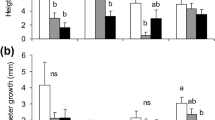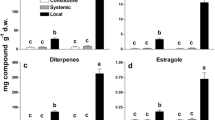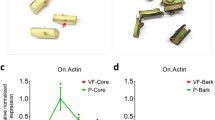Abstract
The potential role of the resin system in the response of Austrian pine (Pinus nigra Arn.) seedlings to mechanical injury and fungal infection was studied in greenhouse experiments. Anatomical observations were performed on 2-year-old plants wounded at collar level and inoculated with Sphaeropsis sapinea (Fr.: Fr.) Dyko & Sutton in Sutton or Diplodia scrobiculata (J. de Wet, B. Slippers & M. J. Wingfield, sp. nov.; sensu de Wet et al. 2003), two fungal pathogens that cause shoot blight and canker on conifers, and that are characterized by different levels of aggressiveness. Histological examination of host tissue taken from the stem at 0, 8, and 12 cm above the treatment site revealed significant treatment- and time-dependent effects on the course of locally and systemically induced traumatic resin duct (TRD) development. Occurrence of TRDs was observed after 4 days only in seedlings inoculated with D. scrobiculata. At 12 days, TRDs were present also in mock-inoculated controls. No TRDs appeared in seedlings inoculated with S. sapinea. However, S. sapinea caused loss of vacuolar phenolics, severe disruption of cambial tissue and invaded the host xylem quickly and apparently unimpeded, whereas D. scrobiculata was never detected in the host xylem. Five-year-old Austrian pines subjected to the same stem base treatments were used to determine the resin mass flowing from the stem 30 cm above the treatment sites. Wounding and/or inoculation induced a significant, 8.3-fold average increase in systemic resin flow over the untreated trees 3 weeks after basal treatment, suggesting that wounding is the sole prerequisite for systemic induction of resin flow. The results are discussed in the context of current disease resistance models.



Similar content being viewed by others
Abbreviations
- ANOVA :
-
Analysis of variance
- LSD :
-
Least significant difference
- PB :
-
Polyphenolic body
- SIR :
-
Systemic induced resistance
- TRD :
-
Traumatic resin duct
- WA :
-
Water agar
References
Bannan MW (1936) Vertical resin ducts in the secondary wood of the Abietineae. New Phytol 35:11–46
Berryman AA (1972) Resistance in conifers to invasion by bark beetle–fungus associations. Bioscience 22:598–602
Blanchette RA, Biggs AR (1992) Defense mechanisms of woody plants against fungi. Springer, Berlin Heidelberg New York, pp 458
Blodgett JT, Bonello P (2003) The aggressiveness of Sphaeropsis sapinea on Austrian pine varies with isolate group and site of infection. For Pathol 33:15–19
Blodgett JT, Stanosz GR (1997) Sphaeropsis sapinea morphotypes differ in aggressiveness, but both infect nonwounded red or jack pines. Plant Dis 81:143–147
Blodgett JT, Stanosz GR (1999) Differences in aggressiveness of Sphaeropsis sapinea RAPD marker group isolates on several conifers. Plant Dis 83:853–856
Blodgett JT, Bellizzi M, Bonello P (2003a) The induction of systemic resistance and systemic susceptibility in Sphaeropsis sapinea inoculated Pinus nigra. In: Stone J, Maffei H (eds) 50th Western Int Forest Disease Working Conference, USDA Forest Service, Powell River, British Columbia, Canada, pp 46–47
Blodgett JT, Bonello P, Stanosz GR (2003b) An effective medium for isolating Sphaeropsis sapinea from asymptomatic pines. For Pathol 33:395–404
Blua MJ, Perring TM (1992) Effects of zucchini yellow mosaic-virus on colonization and feeding-behavior of Aphis gossypii (Homoptera, Aphididae) alatae. Environ Entomol 21:578–585
Bonello P, Blodgett JT (2003) Pinus nigra–Sphaeropsis sapinea as a model pathosystem to investigate local and systemic effects of fungal infection of pines. Physiol Mol Plant Pathol 63:249–261
Bonello P, Pearce RB, Watt F, Grime GW (1991) An induced papilla response in primary roots of Scots pine challenged in vitro with Cylindrocarpon destructans. Physiol Mol Plant Pathol 39:213–228
Bonello P, Gordon TR, Storer AJ (2001) Systemic induced resistance in Monterey pine. For Pathol 31:99–106
Croteau RB, Johnson MA (1985) Biosynthesis of terpenoid wood extractives. In: Higuchi T (ed) Biosynthesis and biodegradation of wood components. Academic Press, New York, pp 379–439
Davis JM, Wu H, Cooke JEK, Reed JM, Luce KS, Michler CH (2002) Pathogen challenge, salicylic acid, and jasmonic acid regulate expression of chitinase gene homologs in pine. Mol Plant Microbe Interact 15:380–387
de Wet J, Burgess T, Slippers B, Preisig O, Wingfield BD, Wingfield MJ (2003) Multiple gene genealogies and microsatellite markers reflect relationships between morphotypes of Sphaeropsis sapinea and distinguish a new species of Diplodia. Mycol Res 107:557–566
Faldt J, Martin D, Miller B, Rawat S, Bohlmann J (2003) Traumatic resin defense in Norway spruce (Picea abies): methyl jasmonate-induced terpene synthase gene expression, and cDNA cloning and functional characterization of (+)-3-carene synthase. Plant Mol Biol 51:119–133
Feci E, Battisti A, Capretti P, Tegli S (2002) An association between the fungus Sphaeropsis sapinea and the cone bug Gastrodes grossipes in cones of Pinus nigra in Italy. For Pathol 32:241–247
Felton GW, Broadway RM, Duffey SS (1989) Inactivation of protease inhibitor activity by plant-derived quinones—complications for host-plant resistance against Noctuid herbivores. J Ins Phys 35:981–990
Finstein MS, Miller FC, Strom PF, Macgregor ST, Psarianos KM (1983) Composting ecosystem management for waste treatment. Bio Technol 1:347–353
Franceschi VR, Krokene P, Krekling T, Christiansen E (2000) Phloem parenchyma cells are involved in local and distant defense responses to fungal inoculation or bark-beetle attack in Norway spruce (Pinaceae). Am J Bot 87:314–326
Franceschi VR, Krekling T, Christiansen E (2002) Application of methyl jasmonate on Picea abies (Pinaceae) stems induces defense-related responses in phloem and xylem. Am J Bot 89:578–586
Hammerschmidt R, Nicholson RL (1999) A survey of plant defense responses to pathogens. In: Agrawal AA, Tuzun S, Bent E (eds) Induced plant defenses against pathogens and herbivores. APS Press, St. Paul, MN, pp 55–71
Hudgins JW, Christiansen E, Franceschi VR (2003) Methyl jasmonate induces changes mimicking anatomical defenses in diverse members of the Pinaceae. Tree Physiol 23:361–371
Hudgins JW, Christiansen E, Franceschi VR (2004) Induction of anatomically based defense responses in stems of diverse conifers by methyl jasmonate: a phylogenetic perspective. Tree Physiol 24:251–264
Inbar M, Doostdar H, Sonoda RM, Leibee GL, Mayer RT (1998) Elicitors of plant defensive systems reduce insect densities and disease incidence. J Chem Ecol 24:135–149
Kinloch BB, Sniezko RA, Barnes GD, Greathouse TE (1999) A major gene for resistance to white pine blister rust in western white pine from the Western Cascade Range. Phytopathology 89:861–867
Klepzig KD, Kruger EL, Smalley EB, Raffa KF (1995) Effects of biotic and abiotic stress on induced accumulation of terpenes and phenolics in red pines inoculated with bark beetle-vectored fungus. J Chem Ecol 21:601–626
Krekling T, Franceschi VR, Krokene P, Solheim H (2004) Differential anatomical response of Norway spruce stem tissues to sterile and fungus infected inoculations. Trees Struct Func 18:1–9
Maresi G, Ambrosi P, Battisti A, Capretti P, Danti R, Feci E, Minerbi S, Tegli S (2002) Pine dieback by Sphaeropsis sapinea in Northern and Central Italy. In: Shoot and foliage diseases. Forest research institute research papers. Proceedings of the IUFRO Working Party 7.02.02. Hyytiala, Finland, pp 60–67
Martin D, Tholl D, Gershenzon J, Bohlmann J (2002) Methyl jasmonate induces traumatic resin ducts, terpenoid resin biosynthesis, and terpenoid accumulation in developing xylem of Norway spruce stems. Plant Physiol 129:1003–1018
Martin DM, Gershenzon J, Bohlmann J (2003) Induction of volatile terpene biosynthesis and diurnal emission by methyl jasmonate in foliage of Norway spruce. Plant Physiol 132:1586–1599
McKay SAB, Hunter WL, Godard KA, Wang SX, Martin DM, Bohlmann J, Plant AL (2003) Insect attack and wounding induce traumatic resin duct development and gene expression of (−)-pinene synthase in Sitka spruce. Plant Physiol 133:368–378
McNee WR, Bonello P, Wood DL, Storer AJ, Gordon TR (2003) Feeding response of Ips paraconfusus to phloem and phloem metabolites of Heterobasidion annosum-inoculated ponderosa pine, Pinus ponderosa. J Chem Ecol 29:1183–1202
Metraux JP (2001) Systemic acquired resistance and salicylic acid: current state of knowledge. Eur J Plant Pathol 107:13–18
Nagy NE, Franceschi VR, Solheim H, Krekling T, Christiansen E (2000) Wound-induced traumatic resin duct development in stem of Norway spruce (Pinaceae): anatomy and cytochemical traits. Am J Bot 87:302–313
Nebeker TE, Hodges JD, Blanche CA (1993) Host response to bark beetle and pathogen colonization. In: Schowalter TD, GM Filip (eds) Beetle-pathogen interactions in conifer forests. Academic Press, London, pp 157–173
Phillips MA, Croteau RB (1999) Resin-based defenses in conifers. Trends Plant Sci 4:184–190
Shrimpton DM, Whitney HS (1968) Inhibition of growth of blue stain fungi by wood extractive. Can J Bot 46:757–761
Solheim H (1991) Oxygen deficiency and spruce resin inhibition of growth of fungi associated with Ips typographus. Mycol Res 95:1387–1392
Stanosz GR, Smith DR, Guntmiller MA (1996) Characterization of Sphaeropsis sapinea from the west central United States by means of random amplified polymorphic DNA marker analysis. Plant Dis 80:1175–1178
Stout MJ, SS Duffey (1996) Characterization of induced resistance in tomato plants. Entomol Exp Appl 79:273–283
Swart WJ, Wingfield MJ (1991) Biology and control of Sphaeropsis sapinea on Pinus species in South Africa. Plant Dis 75:761–766
Walton JD (1997) Biochemical plant pathology. In: Dey PM, Harborne JB (eds) Plant biochemistry. Academic Press, San Diego, pp 487–502
Wong BL, Berryman AA (1977) Host resistance to the fir engraver beetle. 3. Lesion development and containment of infection by resistant Abies grandis inoculated with Trichosporium symbioticum. Can J Bot 55:2358–2365
Wu H, Hu Z (1977) Comparative anatomy of resin ducts of the Pinaceae. Trees 11:135–143
Acknowledgements
The authors thank M. Bellizzi for technical assistance, and John Freudenstein (Ohio State University) and Tom Gordon (University of California, Davis) for pre-submission reviews. Salaries and research support were provided by state and federal funds appropriated to the Ohio Agricultural Research and Development Center and The Ohio State University
Author information
Authors and Affiliations
Corresponding author
Rights and permissions
About this article
Cite this article
Luchi, N., Ma, R., Capretti, P. et al. Systemic induction of traumatic resin ducts and resin flow in Austrian pine by wounding and inoculation with Sphaeropsis sapinea and Diplodia scrobiculata. Planta 221, 75–84 (2005). https://doi.org/10.1007/s00425-004-1414-3
Received:
Accepted:
Published:
Issue Date:
DOI: https://doi.org/10.1007/s00425-004-1414-3




